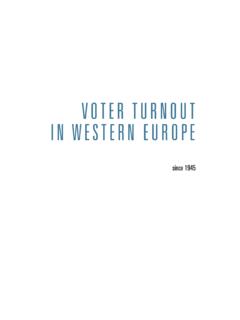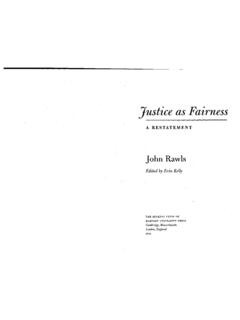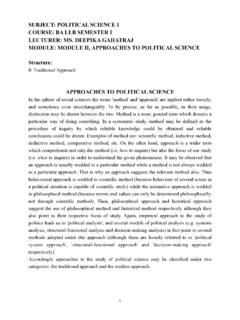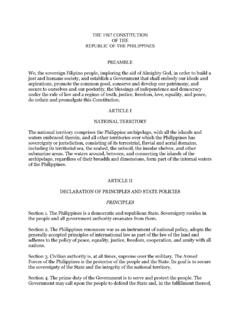Transcription of What is a Constitution? Principles and Concepts
1 what is a constitution ? Principles and ConceptsInternational IDEA constitution -Building Primer 1 what is a constitution ? Principles and ConceptsInternational IDEA constitution -Building Primer 1 Elliot Bulmer 2017 International Institute for Democracy and Electoral Assistance Second edition. First published in 2014 by International IDEA publications are independent of specific national or political interests. Views expressed in this publication do not necessarily represent the views of International IDEA, its Board or its Council electronic version of this publication is available under a Creative Commons Attribute- NonCommercial-ShareAlike (CC BY-NC-SA ) licence. You are free to copy, distribute and transmit the publication as well as to remix and adapt it, provided it is only for non-commercial purposes, that you appropriately attribute the publication, and that you distribute it under an identical licence.
2 For more information visit the Creative Commons website: < >.International IDEA Str msborg SE 103 34 Stockholm Sweden Telephone: +46 8 698 37 00 Email: Website: < > Design and layout: International IDEA Cover illustration: 123RF, < > ISBN: 978-91-7671-185-9 Created with Booktype: < >International IDEA1. Introduction .. 52. The fundamentals of constitutions .. 6 The functions of a constitution .. 6 The constitution at the intersection of legal, social and political life .. 8 Two constitutional archetypes .. 9 what does a constitution typically contain? .. 10 The constitution and the constitutional order .. 123. Constitutions and democracy .. 13 Why have a constitution ? .. 13 Democratic constitutionalism as a global norm .. 15 Elite accommodation .. 15 Inclusive bargains and precommitments .. 17 Constitutions, corruption and good citizenship .. 19 References.
3 21 Annex .. 23 About the author .. 23 About International IDEA .. 24 About ConstitutionNet .. 25 More International IDEA publications on constitution -building processes .. 26 About this series .. 27 ContentsInternational IDEA 51. Introduction1. IntroductionThe vast majority of contemporary constitutions describe the basic Principles of the state, the structures and processes of government and the fundamental rights of citizens in a higher law that cannot be unilaterally changed by an ordinary legislative act. This higher law is usually referred to as a content and nature of a particular constitution , as well as how it relates to the rest of the legal and political order, varies considerably between countries, and there is no universal and uncontested definition of a constitution . Nevertheless, any broadly accepted working definition of a constitution would likely describe it as a set of fundamental legal-political rules binding on everyone in the state, including ordinary law-making institutions; the structure and operation of the institutions of government, political Principles and the rights of citizens; based on widespread public legitimacy; harder to change than ordinary laws ( a two-thirds majority vote or a referendum is needed); a minimum, meet the internationally recognized criteria for a democratic system in terms of representation and human International IDEAWhat is a constitution ?
4 Principles and Concepts2. The fundamentals of constitutionsThe functions of a can declare and define the boundaries of the political community. These boundaries can be territorial (the geographical borders of a state, as well as its claims to any other territory or extra-territorial rights) and personal (the definition of citizenship). Thus, a constitution often distinguishes between those inside and outside the can declare and define the nature and authority of the political community. They often declare the state s fundamental Principles and assumptions, as well as where its sovereignty lies. For example, the French constitution declares that France is an indivisible, secular, democratic and social Republic and that National sovereignty belongs to the people, who exercise it through their representatives and by means of referendums . The constitution of Ghana (1992) states that The Sovereignty of Ghana resides in the people of Ghana in whose name and for whose welfare the powers of government are to be exercised.
5 Can express the identity and values of a national community. As nation-building instruments, constitutions may define the national flag, anthem and other symbols, and may make proclamations about the values, history and identity of the nation. can declare and define the rights and duties of citizens. Most constitutions include a declaration of fundamental rights applicable to citizens. At a minimum, these will include the basic civil International IDEA 72. The fundamentals of constitutionsliberties that are necessary for an open and democratic society ( the freedoms of thought, speech, association and assembly; due process of law and freedom from arbitrary arrest or unlawful punishment). Many constitutions go beyond this minimum to include social, economic and cultural rights or the specific collective rights of minority communities. And some rights may apply to both citizens and non-citizens, such as the right to be free from torture or physical can establish and regulate the political institutions of the community.
6 Constitutions define the various institutions of government; prescribe their composition, powers and functions; and regulate relations between them. Almost all constitutions establish legislative, executive and judicial branches of government. In addition, there may be a symbolic head of state, institutions to ensure the integrity of the political process ( an electoral commission), and institutions to ensure the accountability and transparency of those in power ( an ombudsman). The institutional provisions typically provide mechanisms for the democratic allocation and peaceful transfer of power ( elections) and for the restraint and removal of those who abuse power or who have lost the confidence of the people ( impeachment procedures). can divide or share power between different layers of government or sub-state communities. Many constitutions establish federal, quasi-federal or decentralized processes for the sharing of power between provinces, regions or other sub-state communities.
7 These may be geographically defined (as in most federations, such as Argentina, Canada or India), or they may be defined by cultural or linguistic communities ( the 1994 constitution of Belgium, which establishes autonomous linguistic communities in addition to geographical regions). can declare the official religious identity of the state and demarcate relationships between sacred and secular authorities. This is particularly important in societies where religious and national identities are interrelated, or where religious law has traditionally determined matters of personal status or the arbitration of disputes between can commit states to particular social, economic or developmental goals. This may take the form of judicially enforceable socio-economic rights, directive Principles that are politically binding on the government, or other expressions of commitment or International IDEAWhat is a constitution ?
8 Principles and ConceptsThe constitution at the intersection of legal, social and political lifeAs legal, political and social documents, constitutions are at the intersection of the legal system, the political system and society (see Figure ).Figure A constitution as a legal, social and political documentConstitutions as legal instrumentsA constitution marries power with justice (Lutz 2006: 17) it makes the operation of power procedurally predictable, upholds the rule of law, and places limits on the arbitrariness of power. It is the supreme law of the land, and it provides the standards that ordinary statutes have to comply as social declarationsConstitutions often attempt, to varying degrees, to reflect and shape society for example, by expressing the (existing or intended) common identity and aspirations of the people, or by proclaiming shared values and ideals.
9 These provisions are generally found in preambles and opening declarations, but can also be found in oaths and mottos or on flags and other symbols that are defined by the constitution . Other substantive provisions of the constitution , particularly those defining socio-economic rights, cultural or linguistic policy, or education, might also belong to this category (Lutz 2006: 16 7).International IDEA 92. The fundamentals of constitutionsConstitutions as political instrumentsThe constitution prescribes a country s decision-making institutions: constitutions identify the supreme power , distribute power in a way that leads to effective decision making and provide a framework for continuing political struggle (Lutz 2006: 17). The political provisions show how state institutions (parliament, executive, courts, head of state, local authorities, independent bodies, etc.)
10 Are constituted, what powers they have and how they relate to one constitutional archetypesConstitutions balance and reconcile these legal, political and social functions in different ways. Two broad constitutional archetypes can be identified: the procedural and the prescriptive. The differences between these two types of constitutions relate to the nature and purposes of the document constitutionsA procedural constitution defines the legal and political structures of public institutions and sets out the legal limits of government power in order to protect democratic processes and fundamental human procedural constitution may be appropriate in cases where it is difficult to arrive at a common agreement over issues of values or identity, but where it is possible to reach a more limited and pragmatic consensus on using democratic procedures to resolve these differences.


















